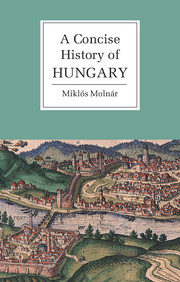Book contents
- Frontmatter
- Contents
- List of illustrations
- Acknowledgements
- Chronology
- 1 FROM THE BEGINNINGS UNTIL 1301
- 2 GRANDEUR AND DECLINE: FROM THE ANGEVIN KINGS TO THE BATTLE OF MOHÁCS, 1301–1526
- 3 A COUNTRY UNDER THREE CROWNS, 1526–1711
- 4 VIENNA AND HUNGARY: ABSOLUTISM, REFORMS, REVOLUTION, 1711–1848/9
- 5 RUPTURE, COMPROMISE AND THE DUAL MONARCHY, 1849–1919
- 6 BETWEEN THE WARS
- 7 UNDER SOVIET DOMINATION, 1945–1990
- 8 1990, A NEW DEPARTURE
- Bibliographical notes
- Index
5 - RUPTURE, COMPROMISE AND THE DUAL MONARCHY, 1849–1919
Published online by Cambridge University Press: 05 June 2014
- Frontmatter
- Contents
- List of illustrations
- Acknowledgements
- Chronology
- 1 FROM THE BEGINNINGS UNTIL 1301
- 2 GRANDEUR AND DECLINE: FROM THE ANGEVIN KINGS TO THE BATTLE OF MOHÁCS, 1301–1526
- 3 A COUNTRY UNDER THREE CROWNS, 1526–1711
- 4 VIENNA AND HUNGARY: ABSOLUTISM, REFORMS, REVOLUTION, 1711–1848/9
- 5 RUPTURE, COMPROMISE AND THE DUAL MONARCHY, 1849–1919
- 6 BETWEEN THE WARS
- 7 UNDER SOVIET DOMINATION, 1945–1990
- 8 1990, A NEW DEPARTURE
- Bibliographical notes
- Index
Summary
For the next seventy years, Hungary's ties with Austria were to be closer than they had ever been before, first under neo-absolutist constraints, then in the wake of the 1867 compromise. This was also the era of the balance of power on the continent, overseen by England and ‘readjusted’ by several conflicts: the Crimean war (1854–5), Napoleon III's Italian war (1859), the Austro-Prussian war (1866), the Franco-German war (1870–1) and others. The Austrian Empire, which emerged from the 1848–9 crisis unscathed, suffered defeat in Italy and was ousted from Germany by Bismarck's Prussia; its relations with Hungary were shaped by these events. As Austria's international position weakened, Emperor Francis Joseph moved towards the 1867 compromise which was to create the Austro-Hungarian dual monarchy.
THE BACH SYSTEM
After three years of crises, calm prevailed in the Habsburg kingdoms and provinces. The young Francis Joseph succumbed to ‘the intoxication of power’ (Jean-Paul Bled) and opened a neo-absolutist ‘septennat’ not unlike enlightened despotism, but in conjunction with a rise in clericalism. Francis Joseph assumed total control, to the point of presiding over the Government Council in person. Pro-constitutional ministers resigned one after another; Schwarzenberg held his post till his death in 1851. Alexander von Bach, the minister of the interior, who was already very influential, became the architect of the neo-absolutist turn that began in 1850.
- Type
- Chapter
- Information
- A Concise History of Hungary , pp. 201 - 249Publisher: Cambridge University PressPrint publication year: 2001



